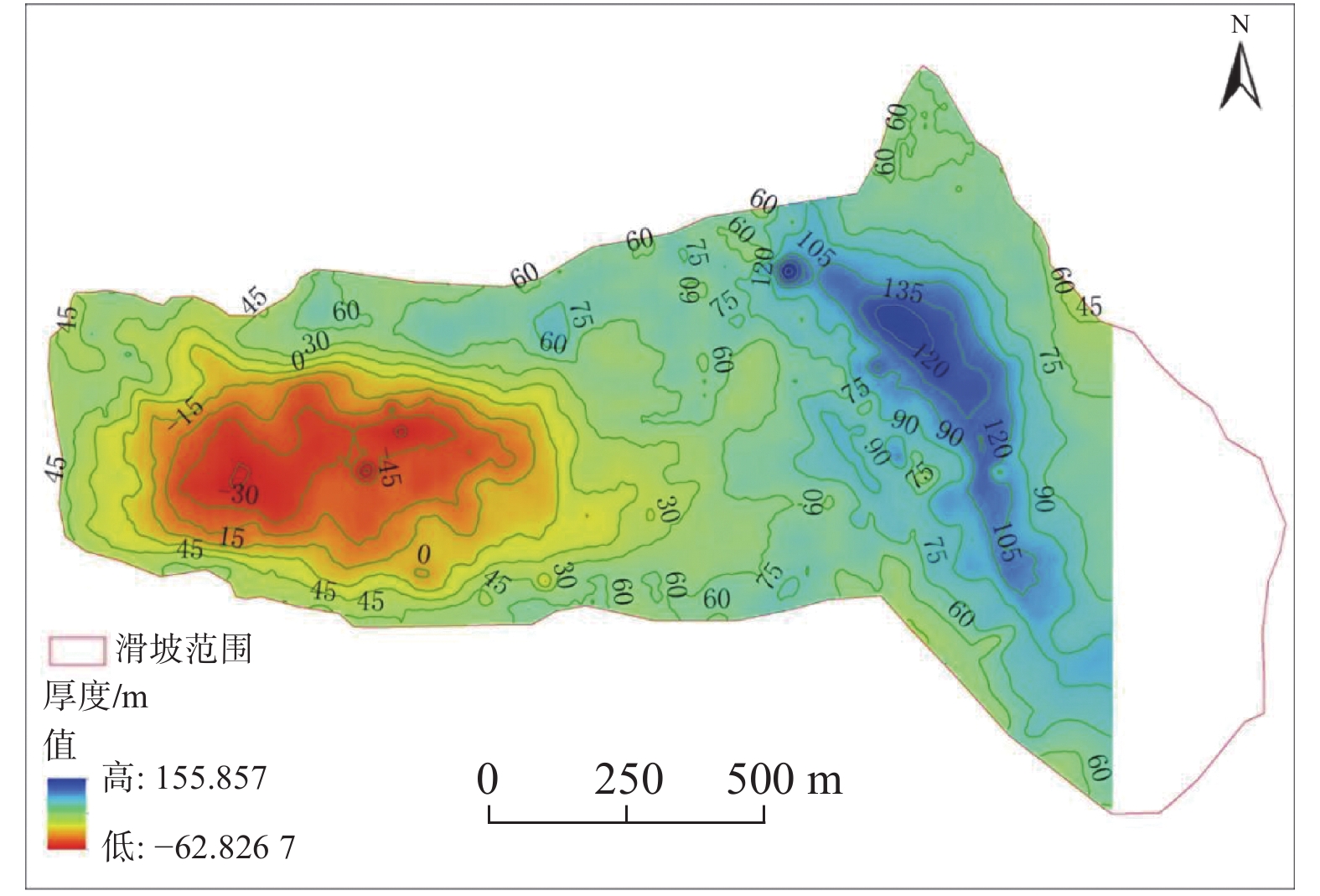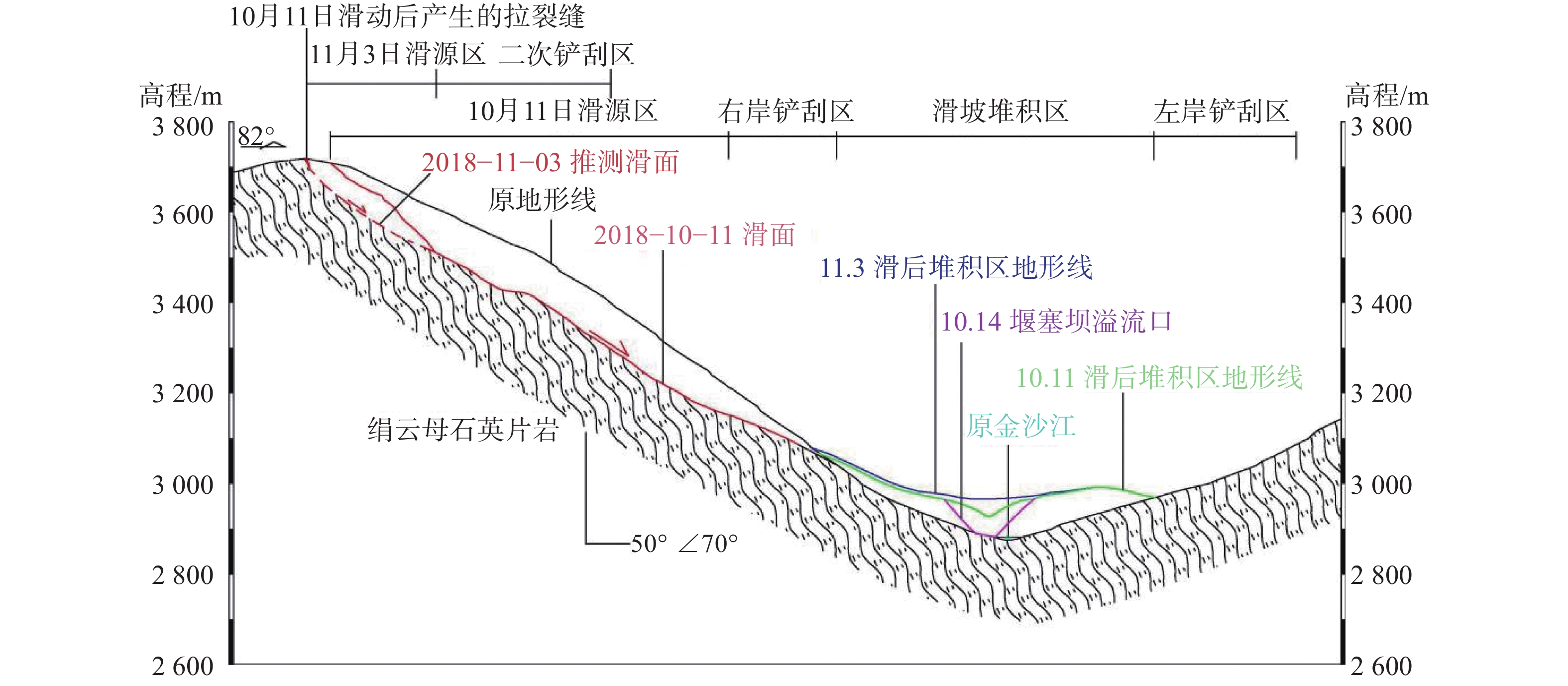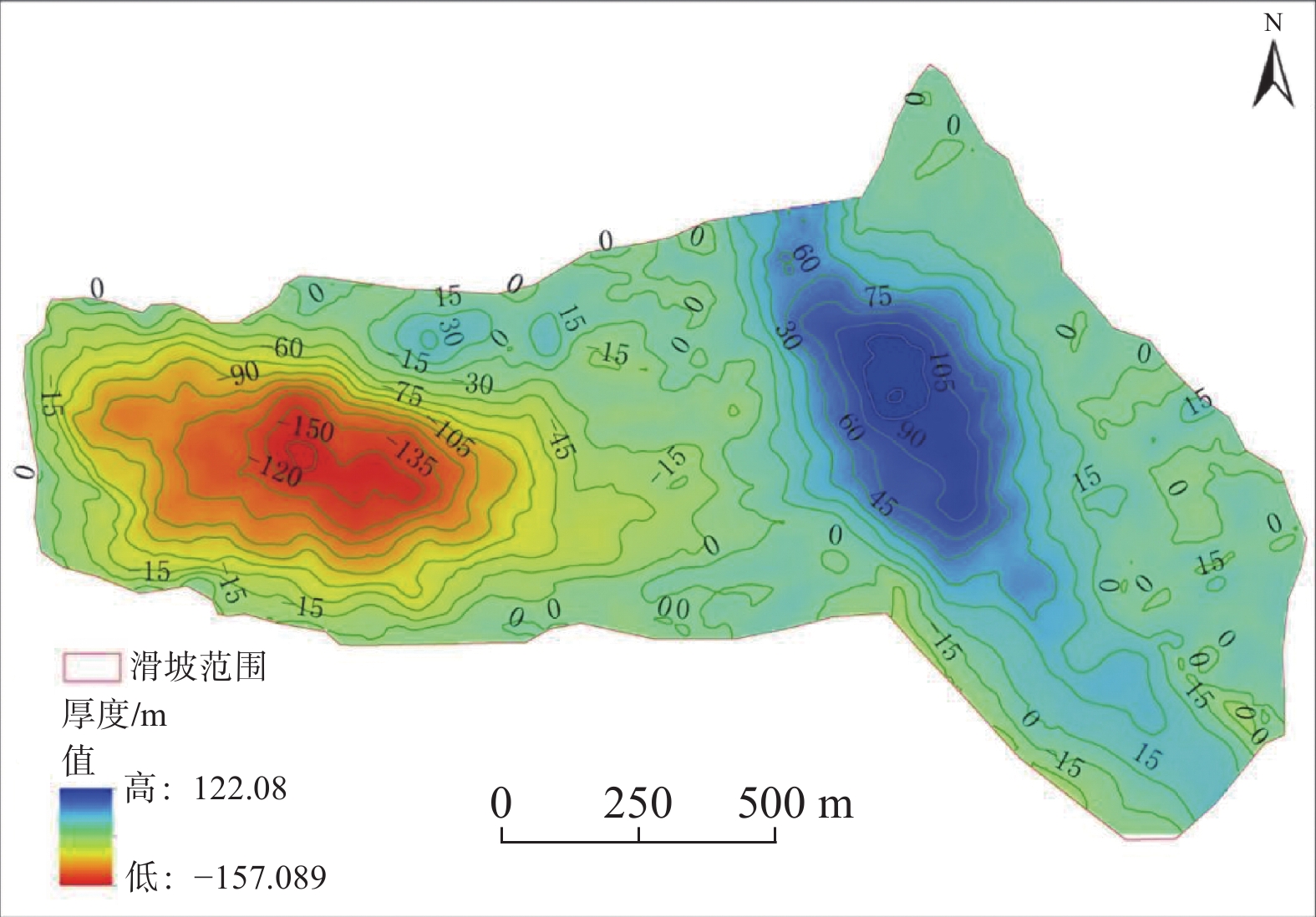Remote sensing dynamic analysis of chain characteristics of long range and high position landslide in Jinsha River junction zone: A case study of Baige landslide
-
摘要: 金沙江结合带由于地质构造发育,地震活动频繁,河谷切割强烈,岸坡高陡狭窄, 岩体极为破碎,历史上发生过多起大型滑坡堵江事件。以白格滑坡两次堵江事件(2018年10月11日、2018年11月3日)为例,采用2009年12月4日至2020年10月16日多期、多源卫星遥感数据源,通过遥感判识、对比分析等方法对滑坡体滑前斜坡变形特征、滑后滑坡堆积特征、滑后斜坡残留体变形特征进行特大型堵江滑坡链式特征遥感动态分析。根据多期遥感影像,将白格滑坡变形特征划分为早期滑动变形阶段(2009—2011年)、稳定变形阶段(2011—2015年)、快速变形阶段(2015—2017年)、剧烈变形阶段(2017—2018年)、变形破坏阶段(2018年以后)等5个阶段。根据滑坡第一次滑后的变形破坏特征,将滑坡划分为滑源区、铲刮区、堆积区以及拉裂变形区。根据滑坡第二次滑后的变形破坏特征,将滑坡划分为二次滑坡滑源区、二次滑坡堆积区(堰塞体)、二次铲刮(堆积)区、二次铲刮区影响区以及拉裂变形区。基于上述研究成果,对白格滑坡灾害链式特征进行总结分析,为金沙江结合带高位远程滑坡灾害链式特征研究提供参考。
-
关键词:
- 堵江滑坡 /
- 白格滑坡 ; 遥感判识 /
- 链式灾害
Abstract:Due to the development of geological structure, frequent seismic activity, strong valley cutting, high steep and narrow bank slope, extremely broken rock mass, there have been many large-scale landslides blocking the Jinshajiang River in history.Taking the two river blocking events of Baige landslide (October 11, 2018 and November 3, 2018) as an example, this paper uses the multi-phase and Multi-source Satellite remote sensing data sources from December 4, 2009 to October 16, 2020 to analyze the deformation characteristics of the slope before sliding, the accumulation characteristics of the slope after sliding and the residual deformation characteristics of the slope after sliding by means of remote sensing identification and comparative analysis The analysis of telemotional states. According to the multi-stage remote sensing images, the deformation characteristics of Baige landslide are divided into five areas: early sliding deformation stage (2009-2011), stable deformation stage (2011-2015), rapid deformation stage (2015-2017), severe deformation stage (2017-2018) and deformation failure stage (after 2018). According to the deformation and failure characteristics of the landslide, the landslide is divided into sliding source area, scraping area, accumulation area and tensile fracture deformation area. According to the deformation and failure characteristics of the landslide after the second sliding, the landslide is divided into the secondary landslide source area, the secondary landslide accumulation area (weir body), the secondary scraping (accumulation) area, the secondary scraping affected area and the tensile fracture deformation area. Based on the above research results, this paper summarizes and analyzes the chain characteristics of Baige landslide disaster, which provides a reference for the research on the chain characteristics of long range and high position landslide disasters in Jinsha River junction zone. -
0. 引言
随着我国公路、铁路等基础设施建设的推进,工程中遇到了大量的岩质边坡崩塌破坏、风化剥落等问题,尤其在西部山区国(省)干道的升级改造过程中,这种现象最为严重[1-5]。由于山区道路地形地质复杂,地质构造运动剧烈,表层岩体风化剥蚀强烈,多呈碎裂状态。在地震、暴雨及工程开挖卸荷扰动等因素共同作用下,边坡整体稳定性和浅表层稳定性问题共同构成影响道路运营安全的重要因素。
学者们对该类岩质边坡变形破坏开展了大量研究,贺凯等[6]针对高陡岩体底部压裂失稳模式,提出了考虑底部薄弱区域损伤演化的边坡整体稳定性评价方法。张科等[7]基于运动单元法对岩质边坡复合型破坏机制进行研究表明,岩桥位置、结构面贯通度和结构面倾角是控制力学行为的三个主要因素。罗洪成等[8]利用现场勘测和数值模拟方法分析了富水破碎岩质边坡的滑坡成因和特征,指出岩体后缘拉裂引起前部剪切破坏,最后导致边坡整体失稳。张广甫等[9]基于贯通率法对危岩主控结构面主要强度参数、值取值进行了研究。严豪等[10]基于Voronoi节理模型分析了碎裂岩质边坡破坏是从坡顶以一定深度向坡脚贯通发展的。徐前卫等[11]通过室内模型试验总结出坡顶岩体张拉破坏与坡脚岩体压剪破坏共同造成直立软弱破碎岩质边坡塌方,具有渐进性特征。霍宇翔等[12]通过对碎裂岩质边坡监测表明,稳定性由多组相交结构面控制,受结构面产状及分布规律影响较大。曹兴松[13]则通过分析碎裂岩质边坡病害特征,总结出边坡破坏模式、形成机制和失稳过程,指出边坡高陡、岩体风化及降雨软化等是主要影响因素。
由此可知,目前对岩质边坡研究,多集中于边坡整体稳定性加固防护方面,设计治理也多采用框架或垫墩锚索等[14-16]。针对边坡浅表层岩土体失稳,多在坡表采用与短锚杆相结合的SNS主动防护网进行加固[17-19](图1)。
对破碎岩质边坡浅表层岩体防护,通常采用SNS主动防护网[17-18]。即通过3~4 m长的短锚杆将主动防护网固定于坡面上,通常锚杆拉力不超过50 kN。实际上,此类短锚杆并不能为边坡提供足够的锚固力,一旦坡体发生整体失稳,难以起到加固作用,并不是严格意义上的主动防护。现阶段对SNS主动防护网的研究主要为工程应用介绍及防护效果评价,对其防护作用机理及受力特点也多局限于单元网格结构受力分析[18-20]。
综上,目前针对深层加固的锚索+浅层防护的SNS主动防护网的联合协同受力研究较少。基于此,本文提出锚墩式主动防护网新型结构设计方法,以有效克服山区破碎岩质边坡加固防护难题。
1. 锚墩式主动防护网组合结构
1.1 锚墩式主动防护网结构组成
锚墩式主动防护网的突出特点在于:在主动防护网结构的节点处设置垫墩锚索代替传统的短锚杆,以实现该结构对边坡的深层加固(图2)。
其结构主要由以下部分组成:横向支撑绳①、纵向支撑绳②、缝合绳③、高强度钢绳网④、锚墩⑤、加固锚索⑥及固定短锚杆⑦。
其特征是:设置于坡顶与坡脚处的固定短锚杆主要起定位高强度钢绳网的作用。设置于网格节点处的锚墩和加固锚索,锚墩与网格节点处的纵向支撑绳、横向支撑绳形成固定连接,加固锚索则穿越坡体内潜在深层滑动面锚入稳定基岩体中,主要起到深层加固作用。高强度钢绳网呈曲面状铺设于坡面,通过缝合绳与网格周边的纵向支撑绳、横向支撑绳连接,并分隔成网格状。通过向张拉缝合绳与支撑绳施加作用力对高强度钢绳网进行预张拉,主要起到表层防护作用。
工程应用中的支撑绳与缝合绳应选用满足工程使用年限的钢丝绳(如磷化涂层钢丝绳),当需对锚墩间主动防护网单元进行破损置换或修补时,可通过解开缝合绳将主动防护网与支撑绳进行分离。
为防止水泥锚墩与主动防护网中支撑绳之间因压缩产生磨损及切割作用[21],在锚墩接触面处单独设立双层硬橡胶垫片或双层尼龙垫片(图3)。在支撑绳受力时,通过给予足够的变形空间,使得锚墩与支撑绳之间能够变形协调,保护主动防护网结构不产生切割破坏。
1.2 锚墩式主动防护网加固机理
加固锚索前端通过锚墩作用于坡面之上,后端则穿越坡体内潜在深层滑动面,锚入稳定基岩体之中。通过对锚索施加预应力进行边坡加固,可有效提高边坡稳定性,防止产生整体失稳破坏。
高强度钢绳网覆盖岩质边坡坡面,利用钢丝绳的预张拉作用力及粗糙坡面之间的摩擦力,可阻止破碎岩质边坡锚墩间岩土体向外侧的移动,有效的加固区域内边坡浅表层破碎块体,防止发生局部块体崩落。
由此可知,锚墩式主动防护网能同时解决边坡整体失稳与浅表层失稳问题,是山区道路破碎岩质边坡工程中行之有效的主动防护结构。
2. 锚墩式主动防护网设计方法
2.1 设计计算模型
在锚墩式主动防护网中以相邻的4个锚墩所围成的封闭区域作为研究对象,将其视为一个防护网格单元(图2)。在进行锚墩式主动防护网设计时,根据边坡浅表层岩体情况,在计算表层岩土体失稳带来的锚索轴力增量时,可按以下两种情况进行考虑。
(1)若单元格内有可探明结构和力学参数的危岩体,则可按图4所示力学模型进行计算。设危岩体主控结构面水平夹角为
${\beta _1}$ (°),黏聚力为${c_1}$ (kN/m2),内摩擦角为${\varphi _1}$ (°),竖向高度为${H_1}$ (m),岩体单宽自重为${G_1}$ (kN/m)。结构面处稳定岩体对危岩体的单宽作用力为${N_1}$ (kN/m)。主动防护网加固浅表层岩体的分布力为${q_1}$ (kN/m2),由于钢绳网为柔性结构,可将其等效于一个水平夹角为${\theta _1}$ (°)的单宽合力${F_1}$ (kN/m)。破碎岩质边坡,具有高陡、易风化等特点,在岩体风化作用下结构面裂隙不断扩展,边坡失稳主要表现为产生水平向外的位移[22-25],为了简化分析,可取${\theta _1}$ 为0°。根据危岩体稳定性计算方法,安全系数
${F_{\rm{s}}}$ ,可按公式(1)进行计算。$${F_{\rm{s}}} = \frac{{{F_1}\cos {\beta _1} + \left( {{G_1}\cos {\beta _1} + {F_1}\sin {\beta _1}} \right)\tan {\varphi _1} + {c_1}\dfrac{{{H_1}}}{{\sin {\beta _1}}}}}{{{G_1}\sin {\beta _1}}}$$ (1) 式中:
${c_1}$ ——危岩体结构面黏聚力/(kN·m−2);${\varphi _1}$ ——危岩体结构面内摩擦角/(°);${\beta _1}$ ——危岩体主控结构面水平夹角/(°);${H_1}$ ——危岩体竖向高度/m;${G_1}$ ——危岩体单宽自重/(kN·m−1);${F_1}$ ——钢绳网单宽作用力合力/(kN·m−1)。按规范要求确定安全系数
${F_{\rm{s}}}$ 后,钢绳网单宽作用力合力${F_1}$ ,可按式(2)进行反算:$${F_1} = \frac{{{F_{\rm{s}}}{G_1}{{\sin }^2}{\beta _1}{\rm{ - }}{G_1}\sin {\beta _1}\cos {\beta _1}\tan {\varphi _1} - {c_1}{H_1}}}{{\sin {\beta _1}\cos {\beta _1} + {{\sin }^2}{\beta _1}\tan {\varphi _1}}}$$ (2) 根据静力平衡条件可知,主动防护网通过锚索提供的锚固力和边坡浅表层岩土体对主动防护网的作用力是一对平衡力。如图2所示,设锚索间距为水平间距B1(m)×沿坡面竖向间距
${H_1}$ (m),考虑到每个单元格内有4束锚索共同作用(每束锚索为4个单元格提供锚固力),由图5可知,每束锚索由边坡浅表层失稳带来的轴力增量$\Delta {f_1}$ (kN),可按公式(3)进行计算。$$\Delta {f_1} = \frac{1}{4} \cdot \frac{{{B_1}{F_1}}}{{\cos {\alpha _1}}} \cdot 4 = \frac{{{B_1}{F_1}}}{{\cos {\alpha _1}}}$$ (3) 式中:
${\alpha _1}$ ——锚索的锚固角/(°);B1——锚索水平间距/m。
(2)若单元格内岩体无明显主控结构面或为坡面较为完整的高陡切方岩质边坡,则可按图6所示力学模型进行计算。通过在网格节点的锚墩位置处作两条与锚索夹角为45°+φ2
/2的作用线,由坡面线与两条作用线所围成区域即为边坡浅表层潜在不稳定滑体部分。 此时,可参照地基基础设计计算,通过对锚索施加预应力,锚墩会对坡面产生作用力,可将锚墩作为一个方形基础考虑。如图7(a)所示,根据硬质土整体剪切破坏模式,当荷载达到某一数值时,基础边缘土体先发生剪切破坏,随着荷载增加,破坏区不断扩大,最后形成连续滑动面,导致基底土体向四周挤出,产生整体失稳破坏。如图7(b)所示,地基中Ⅰ区为三角形压密区,该区岩土体直接受压并向两侧挤压,称为主动区;Ⅱ区为被动变形区,该区岩土体受Ⅰ区挤压产生被动变形,称为被动区;基础底部外侧Ⅲ区,由于有临空面为三角形极限平衡区。根据摩尔应力圆图(图7c),Ⅰ区与Ⅱ区分界面AC和BC与基础底面AB(大主应力作用面)的夹角为45°+ φ 2 /2;Ⅱ区与Ⅲ区分界面AE(DE)和BE'(D'E')与临空面AD、BD'(小主应力作用面)的夹角为45°−φ 2/2。
根据以上分析可知,将锚墩视作方形基础后,锚索锚固力作用方向即为大主应力方向。如图6所示,由坡面线与锚索夹角为45°的两条作用线所围成的是锚墩外侧受挤压的潜在不稳定岩土体区域,即为图7(b)中的Ⅲ区。在进行锚墩式主动防护网设计时,需考虑该区域浅表层岩土体失稳带来的锚索轴力增量影响。
划定潜在滑体范围后(图6),各参数设置及简化计算假定与情况1相同,同理安全系数
${F_{\rm{s}}}$ 计算公式为:$${F_{\rm{s}}} = \frac{{{F_2}\cos {\beta _2} + \left( {{G_2}\cos {\beta _2} + {F_2}\sin {\beta _2}} \right)\tan {\varphi _2} + {c_2}{L_2}}}{{{G_2}\sin {\beta _2}}}$$ (4) 其中:
${L_2} = \dfrac{{{H_2}}}{2}\left( {\dfrac{1}{{\cos {\theta _1}}} + \dfrac{1}{{\cos {\theta _2}}}} \right)$ ,${\theta _1} = 45^\circ - \dfrac{{{\varphi _2}}}{2} - \delta$ ,${\theta _2} = 45^\circ - \dfrac{{{\varphi _2}}}{2} + \delta$ ;式中:
${F_2}$ ——钢绳网单宽作用力合力/(kN·m−1);${\,\beta _2}$ ——潜在滑体滑动面水平夹角/(°);${G_2}$ ——潜在滑体单宽自重/(kN·m−1);${\varphi _2}$ ——潜在滑面内摩擦角/(°);${c_2}$ ——潜在滑面黏聚力/(k·Nm-2);${L_2}$ ——潜在滑体滑动面长度/m;${H_2}$ ——潜在滑体沿坡面竖向高度/m;${\theta _1}$ ——下部潜在滑面与坡面的夹角/(°);${\theta _2}$ ——上部潜在滑面与坡面的夹角/(°);$\delta $ ——坡面线与锚索法向线的夹角/(°)。按规范要求确定安全系数
${F_{\rm{s}}}$ 后,钢绳网单宽作用力合力${F_2}$ ,可按式(4)进行反算:$${F_2} = \frac{{{F_{\rm{s}}}{G_2}{{\sin }^2}{\beta _2} - {G_2}\sin {\beta _2}\cos {\beta _2}\tan {\varphi _2} - {c_2}{L_2}\sin {\beta _2}}}{{\sin {\beta _2}\cos {\beta _2} + {{\sin }^2}{\beta _2}\tan {\varphi _2}}}$$ (5) 同理可得每束锚索由边坡浅表层失稳带来的轴力增量
$\Delta {f_2}$ (kN)的计算公式:$$\Delta {f_2} = \frac{1}{4} \cdot \frac{{{B_2}{F_2}}}{{\cos {\alpha _2}}} \cdot 4 = \frac{{{B_2}{F_2}}}{{\cos {\alpha _2}}}$$ (6) 式中:
${\alpha _2}$ ——锚索的锚固角/(°);B2——锚索水平间距/m。
由上可知,锚墩式主动防护网加固设计关键在于确定浅表层潜在不稳定岩土体范围。根据边坡稳定性设计要求,计算出加固该区域岩土体的所需的锚固力。并将该部分锚固力计入主体防护结构,如预应力锚索的锚固力设计中。
2.2 设计计算步骤
为使锚墩式主动防护网新型组合结构加固边坡实现受力协调,提出以下设计计算步骤(图8)。
(1)边坡加固适用性论证
根据边坡地质条件勘察报告,评估锚墩式主动防护网加固的适用性。
(2)边坡稳定性分析
根据规范要求的设计安全系数,通过对预加固边坡进行稳定性分析计算,获得以下结果:
①确定锚索布置及初始锚固力
${P_0}$ 通过边坡整体滑动稳定性分析,计算剩余下滑力,确定锚索布设位置、间距、锚固角及初始锚固预应力
${P_0}$ 。②确定主动防护网受力
$F$ 通过边坡浅表层地质情况结合锚索布置,确定每个防护单元内岩土体浅表层滑动破坏区域,进行坡面稳定性分析,计算主动防护网结构受力
$F$ 。(3)计算锚索预应力
${P_{\rm{t}}}$ 通过主动防护网受力
$F$ ,计算作用在锚索上的轴力增量$\Delta f$ ,确定锚索预应力${P_{\rm{t}}} = {P_0} + \Delta f$ 。(4)锚墩式主动防护网设计
在锚索布置间距和主动防护网单元尺寸大小,结构受力等情况明确的条件下进行锚墩式主动防护网设计。
3. 工程设计实例
3.1 边坡概况
实例边坡位于中江县太安镇境内,在沪蓉高速南充至成都扩建段K1 895+750—K1 895+860(双向4车道扩建为8车道)左侧,长约110 m。边坡属浅丘地貌,覆盖层很薄,层厚约0.5~1 m;下伏基岩为侏罗系上统蓬莱镇组(J3p)粉砂质泥岩、砂岩,产状:321°∠7°。钻孔揭示厚度达35 m,其中强风化带厚2~5 m,强卸荷带厚3~7 m。表层岩体破碎、裂隙密集、岩芯多呈薄片状,无明显主控结构面,且粉砂质泥岩具有饱水软化、失水开裂特性。原挖方边坡高度约47 m,采用缓坡比+宽平台方式开挖(综合坡比1∶1.0~1∶1.25),泥岩段采用护面墙进行护面(图9)。
3.2 边坡扩挖防护设计
本段路基为双侧加宽段,其单侧加宽3.75×2=7.5 m。设计采用陡坡比+强措施进行开挖收坡,经计算边坡坡脚开挖后,存在整体失稳风险,需进行加固防护。由3.1节可知,开挖坡面位于卸荷裂隙密集的强风化带内,同时应防止浅表层坡体发生失稳破坏。为防止边坡二次开挖失稳,设计第一级边坡采用框架锚杆防护,第二、三级边坡采用锚墩式主动防护网防护(图9)。
采用锚索间距4 m×3 m,锚固角20°,坡比1∶0.75,岩体参数:
$\gamma $ =21 kN/m3,$c$ =8 kN/m2,$\varphi $ =25°;经计算设计初始锚固力${P_0}$ =637.17 kN,主动防护网作用力$F$ =103.26 kN,锚索轴力增量$\Delta f$ =112.49 kN,锚索锚固力${P_{\rm{t}}}$ =740.43 kN。设计锚索采用6根$\varnothing^{\rm{S}} $ 15.24低松弛钢绞线(1860 MPa级),锚索长18~25 m,锚固段长10 m,满足边坡整体及浅表层加固设计要求。通过以上计算得出,由浅表层岩体失稳带来的锚索轴力增量可达到初始锚索轴力的15%~20%,这将使防护结构偏于不安全;因此,在高陡破碎岩质边坡加固设计中应考虑这一影响因素。
3.3 边坡施工及工后状况
如图10所示,施工后主动防护网结构与锚墩形成固定连接,共同对边坡进行防护。
根据工后边坡观测及坡面调查,由于锚索设计时考虑了主动防护网对其产生的锚固力增量,边坡整体稳定性良好。高强度钢绳网覆盖整个加固区坡面,经调查坡表未出现局部块体崩塌、滑移等地质灾害现象,边坡整体防护加固效果良好。
4. 结论
(1)锚墩式主动防护网新型结构将预应力锚索与主动防护网有效联合,实现二者协同受力,可同时完成碎裂岩质边坡的整体加固和坡面防护。
(2)锚墩式主动防护网中主动网的受力应为预应力锚索加固后锚墩间坡面局部岩土体的作用力,局部岩土体的上、下边界分别与坡面呈
$45^\circ - \varphi /2 + \delta $ 、$45^\circ - \varphi /2 - \delta $ 的夹角。预应力锚索的受力除了应满足边坡整体稳定外,还应将主动网受力计入。(3)锚索预应力设计时宜考虑15%~20%的预留量,以应对坡面岩土体在地震或暴雨等条件下对主动网的张拉。
-
表 1 白格滑坡遥感影像统计表
Table 1 Remote sensing image statistics of Baige landslide
序号 日期 卫星名称 分辨率/m 1 2009-12-04 RapidEye-1 5 2 2011-03-04 GeoEye-1 0.41 3 2011-11-25 RapidEye-2 5 4 2012-10-21 RapidEye-4 5 5 2013-10-13 RapidEye-4 5 6 2014-04-30 RapidEye-3 5 7 2014-10-31 GF-1 2 8 2015-02-22 GeoEye-1 0.41 9 2015-11-19 RapidEye-5 5 10 2016-10-20 PlanetScope 3 11 2017-10-16 PlanetScope 3 12 2017-11-21 PlanetScope 3 13 2017-12-12 GF-1 2 14 2017-12-17 PlanetScope 3 15 2017-12-21 GF-2 0.8 16 2018-01-04 BJ-2 0.8 17 2018-01-17 PlanetScope 3 18 2018-02-03 PlanetScope 3 19 2018-02-28 GF-2 0.8 20 2018-03-14 PlanetScope 3 21 2018-04-16 PlanetScope 3 22 2018-05-20 PlanetScope 3 23 2018-06-10 PlanetScope 3 24 2018-07-25 PlanetScope 3 25 2018-08-21 PlanetScope 3 26 2018-09-03 PlanetScope 3 27 2018-09-24 PlanetScope 3 28 2018-09-27 PlanetScope 3 29 2018-10-12 PlanetScope 3 30 2018-10-12 BJ-2 0.8 31 2018-10-12 无人机 0.2 32 2018-10-14 天绘卫星 2 33 2018-10-14 无人机 0.2 34 2018-10-16 无人机 0.1 35 2018-10-17 SuperView-1 0.5 36 2018-10-24 PlanetScope 3 37 2018-11-01 GF-2 0.8 38 2018-11-05 无人机 0.2 39 2018-11-09 无人机 0.1 40 2018-11-11 无人机 0.1 41 2018-11-12 无人机 0.16 42 2018-11-13 无人机 0.1 43 2018-11-14 无人机 0.1 44 2019-02-03 GF-2 0.8 45 2019-06-28 无人机 0.2 46 2020-10-16 GF-2 0.8 表 2 白格滑坡滑前多时相遥感动态解译特征
Table 2 Multi temporal remote sensing dynamic interpretation characteristics of Baige landslide before sliding
序号 日期 数据源 分辨率/m 变形特征 1 2009-12-04 RapidEye-1 5 该期影像显示,滑坡轮廓清晰,坡表发育8处滑塌变形体,滑坡中后部发育3条拉裂缝,一条小路受坡表变形影响已错断。 2 2014-04-30 RapidEye-3 5 滑坡变形加剧。滑坡边界向外扩展,后缘和左侧边界尤为明显;坡表滑塌变形体面积增加,前缘新增加1处滑塌变形体;后缘拉裂缝横向发展延长,由原有的3条拉裂缝合并成2条拉裂缝。 3 2014-10-31 GF-1 2 滑坡中后部变形加剧。滑塌体面积增加,坡表小路整体下滑,距离为15~22 m。该期影像显示,滑坡后缘有公路修建现象。分析认为,公路的开挖扰动对滑坡稳定性造成了一定影响,加剧了滑坡的变形破坏。 4 2015-02-22 GeoEye-1 1 滑坡整体变形加剧。坡表滑塌体面积增加,部分分散发育变形体逐渐合并成一个大规模变形体,并新增多处滑塌变形体;后缘拉裂缝纵向延伸,拉裂缝长度增长;坡表小路有整体下挫滑动迹象,下滑距离为5~8 m。 5 2016-10-20 PlanetScope 3 滑坡整体变形加剧。坡表滑塌体面积增加,后缘拉裂缝增长增宽,坡表小路有整体下挫滑动迹象,下滑距离为10~15 m。 6 2017-12-21 GF-2 0.8 滑坡整体变形加剧。坡表滑塌体面积增加,同时新增加多处滑塌变形体,后缘拉裂缝增长增宽,坡表小路有整体下挫滑动迹象,下滑距离为12~19 m。 7 2018-01-17 PlanetScope 3 滑坡整体变形加剧。坡表滑塌体面积增加,后缘拉裂缝增长增宽;坡表小路有整体下挫滑动迹象,下滑距离为5~8 m。 8 2018-02-28 GF-2 0.8 滑坡整体变形加剧。坡表滑塌体面积增加,中后部拉裂缝明显增多,坡表小路有整体下挫滑动迹象,下滑距离为3~5 m。 9 2018-05-20 PlanetScope 3 滑坡整体变形加剧。坡表滑塌体面积增加,部分拉裂变形坡体发展为滑塌体;坡表小路有整体下挫滑动迹象,下滑距离为5~10 m。 10 2018-06-10 PlanetScope 3 滑坡整体变形加剧。坡表滑塌体面积持续增加,滑坡中前部变形加剧,其滑塌体几乎连成一片;中后部坡表小路有整体下挫滑动迹象,下滑距离为1~3 m。 11 2018-07-25 PlanetScope 3 滑坡整体变形加剧。坡表滑塌体面积持续增加,多处滑塌体连接在一起,形成更大规模的滑塌变形体;中后部坡表小路整体下挫,下滑距离约1 m。 12 2018-08-21 PlanetScope 3 滑坡整体变形加剧。坡表滑塌体面积持续增加,滑坡中前部和滑坡后部分别形成规模更大的滑塌变形体;中后部坡表小路下挫滑动,下滑距离5~10 m。 表 3 白格滑坡滑后多时相遥感动态解译特征
Table 3 Multi temporal remote sensing dynamic interpretation characteristics of Baige landslide after sliding
序号 日期 数据源 分辨率/m 变形特征 1 2018-10-12 无人机 0.2 该期影像显示,滑坡整体下滑堵江。滑坡体宽约790 m,纵向长约2000 m,滑坡主滑方向88°。形成拉裂变形区、滑源区、滑坡堆积区、右岸铲刮区、左岸铲刮区。坡体后缘发育75条拉裂缝,长度不一,形成三处拉裂变形体,滑坡正后方和左后方变形体的拉裂缝密集发育,稳定性较低,存在再次滑塌的可能性。 2 2018-10-14 无人机 0.2 该期影像显示,滑坡堰塞体溃坝。滑坡堰塞体溃坝,将滑坡堆积体分为左岸堆积区、右岸堆积区、左岸溃坝残留堆积区、右岸溃坝残留堆积区;滑坡后缘拉裂缝增加到137条,拉裂变形区面积由原来的15.4×104 m2增加到16.2×104 m2。 3 2018-10-17 Superview-1 0.5 滑坡拉裂变形区面积由原来的16.2×104 m2增加到17.9×104 m2,堆积区部分堆积物被河流带走,左岸堆积区面积减少,右岸堆积区面积持续增加。 4 2018-10-24 Planet Scope 3 m 滑坡拉裂变形区面积减小,滑源区面积增加,拉裂缝减少,滑坡后缘拉裂变形区部分区域产生滑动,增加了滑源区面积;滑源区、铲刮区有崩滑物质滑塌,导致右岸堆积区面积持续增加。 5 2018-11-01 GF-2 0.8 滑坡拉裂变形区面积减小,滑源区面积增加,拉裂缝减少,滑坡右岸堆积区面积持续增加。 6 2018-11-05 无人机 0.2 该期影像显示,滑坡再次发生堵江。滑坡正后方拉裂变形区整体垮塌,后缘边界向后扩展约145 m;滑坡二次滑动堆积体覆盖于早期滑坡堆积体上,再次形成高坝堰塞体,堵塞金沙江;早期滑坡滑源区、铲刮区残留碎屑物受滑塌体冲击作用造成二次滑动,增加二次滑坡堆积体的方量;滑坡二次滑动具有高位远程性质,动能大,铲刮滑坡右侧坡体,形成铲刮影响区。 7 2018-11-09 无人机 0.1 滑坡二次滑动堆积区和滑坡二次铲刮堆积区面积减小,滑坡前缘堰塞湖水位上升,逐渐淹没滑坡堆积区;滑坡前缘堆积体有人工干预迹象,准备人工泄流。 8 2018-11-11 无人机 0.1 滑坡二次滑动堆积区和滑坡二次铲刮堆积区面积持续减小,滑坡前缘堰塞湖水位线持续升高,逐渐淹没滑坡堆积区;滑坡后缘拉裂变形区面积减小,滑源区面积增加,滑坡后缘拉裂变形区持续变形,拉裂缝数量增加,稳定性差,存在再次滑塌的可能性。 9 2018-11-13 无人机 0.1 该期影像显示,滑坡前缘泄流通道贯通。滑坡前缘泄流通道贯通,滑坡堆积物被水流携带冲出,形成浑浊沟道;滑坡后缘持续变形,拉裂变形区面积增加,滑源区面积增加,拉裂缝数量增加,存在再次滑塌的可能性。 10 2018-11-14 无人机 0.1 该期影像显示,滑坡前缘泄流通道扩大。滑坡前缘泄流通道扩大,堰塞体上游水位降低,原本淹没滑坡体出露,分为左右两处滑坡堆积体;堰塞体下游溃坝残留堆积区被金沙江分为左右两处溃坝残留堆积区;滑坡后缘持续变形,拉裂变形区面积增加,滑源区面积增加,拉裂缝数量增加,存在再次滑塌的可能性。 11 2019-02-03 GF-2 0.8 该期影像显示,滑坡正在进行工程治理。枯水期滑坡堰塞体上游水位降低,出露上游溃坝残留堆积区;受河流冲刷作用,大量堰塞体堆积物被冲出,导致堰塞体下游溃坝残留堆积区面积增加。 12 2019-06-28 无人机 0.2 该期影像显示,滑坡正在进行工程治理。雨季金沙江水位上升,上游溃坝残留堆积区面积减小,大量堰塞体堆积物被冲出,下游溃坝左岸残留堆积区面积增加;受人工干预,滑坡堆积区面积增加,下游溃坝左岸残留堆积区面积减小,滑坡后缘拉裂变形区面积减小,部分拉裂变形区域被人工处理,拉裂缝减少。 13 2020-10-16 GF-2 0.8 该期影像显示,滑坡已完成工程治理。滑坡表部松散残留物已清除,后缘变形体进行了削方处理,前缘堵塞河道进行了河道拓宽处理。 -
[1] 朱赛楠, 殷跃平, 王猛, 等. 金沙江结合带高位远程滑坡失稳机理及减灾对策研究: 以金沙江色拉滑坡为例[J]. 岩土工程学报,2021,43(4):688 − 697. [ZHU Sainan, YIN Yueping, WANG Meng, et al. Instability mechanism and disaster mitigation measures of long-distance landslide at high location in Jinsha River junction zone: Case study of Sela landslide in Jinsha river, Tibet[J]. Chinese Journal of Geotechnical Engineering,2021,43(4):688 − 697. (in Chinese with English abstract) [2] 杨成生, 董继红, 朱赛楠, 等. 金沙江结合带巴塘段滑坡群InSAR探测识别与形变特征[J]. 地球科学与环境学报,2021,43(2):398 − 408. [YANG Chengsheng, DONG Jihong, ZHU Sainan, et al. Detection, identification and deformation characteristics of landslide groups by InSAR in Batang section of Jinsha River convergence zone, China[J]. Journal of Earth Sciences and Environment,2021,43(2):398 − 408. (in Chinese with English abstract) [3] 殷跃平. 链状地质灾害的特征与防范应对[J]. 中国地质灾害与防治学报,2017,28(3):3. [YIN Yueping. The characteristics and prevention of chain geological disasters[J]. The Chinese Journal of Geological Hazard and Control,2017,28(3):3. (in Chinese with English abstract) [4] 姚鑫, 戴福初, 陈健. 金沙江干热河谷区滑坡遥感解译研究[J]. 中国地质灾害与防治学报,2006,17(3):18 − 21. [YAO Xin, DAI Fuchu, CHEN Jian. Landslide interpretation of remote sensing images in the dry-hot valley of Jinshajiang River[J]. The Chinese Journal of Geological Hazard and Control,2006,17(3):18 − 21. (in Chinese with English abstract) DOI: 10.3969/j.issn.1003-8035.2006.03.005 [5] 柴贺军, 刘汉超, 张倬元. 中国滑坡堵江的类型及其特点[J]. 成都理工学院学报,1998,25(3):411 − 416. [CHAI Hejun, LIU Hanchao, ZHANG Zhuoyuan. Study on the categories of landslide damming of rivers and their characteristics[J]. Journal of Chengdu University of Technology,1998,25(3):411 − 416. (in Chinese with English abstract) [6] 王家柱, 任光明, 葛华. 金沙江上游某特大型滑坡发育特征及堵江机制[J]. 长江科学院院报,2019,36(2):46 − 51. [WANG Jiazhu, REN Guangming, GE Hua. Development characteristics and river-blocking mechanism of a mega-landslide in the upper reach of Jinsha River[J]. Journal of Yangtze River Scientific Research Institute,2019,36(2):46 − 51. (in Chinese with English abstract) [7] 许强, 郑光, 李为乐, 等. 2018年10月和11月金沙江白格两次滑坡-堰塞堵江事件分析研究[J]. 工程地质学报,2018,26(6):1534 − 1551. [XU Qiang, ZHENG Guang, LI Weile, et al. Study on successive landslide damming events of Jinsha river in Baige village on Octorber 11 and November 3, 2018[J]. Journal of Engineering Geology,2018,26(6):1534 − 1551. (in Chinese with English abstract) [8] 王文科, 黄先龙. 2018年“11·3”金沙江白格堰塞湖应急处置与思考[J]. 中国防汛抗旱,2018,28(12):1 − 2. [WANG Wenke, HUANG Xianlong. Emergency response and reflections on “2018.11.3” barrier lake of Baige in the Jinshajiang River[J]. China Flood & Drought Management,2018,28(12):1 − 2. (in Chinese with English abstract) [9] 邓建辉, 高云建, 余志球, 等. 堰塞金沙江上游的白格滑坡形成机制与过程分析[J]. 工程科学与技术,2019,51(1):9 − 16. [DENG Jianhui, GAO Yunjian, YU Zhiqiu, et al. Analysis on the formation mechanism and process of Baige landslides damming the upper reach of Jinsha River, China[J]. Advanced Engineering Sciences,2019,51(1):9 − 16. (in Chinese with English abstract) [10] 王立朝, 温铭生, 冯振, 等. 中国西藏金沙江白格滑坡灾害研究[J]. 中国地质灾害与防治学报,2019,30(1):1 − 9. [WANG Lichao, WEN Mingsheng, FENG Zhen, et al. Researches on the baige landslide at Jinshajiang river, Tibet, China[J]. The Chinese Journal of Geological Hazard and Control,2019,30(1):1 − 9. (in Chinese with English abstract) [11] 陆会燕, 李为乐, 许强, 等. 光学遥感与InSAR结合的金沙江白格滑坡上下游滑坡隐患早期识别[J]. 武汉大学学报·信息科学版,2019,44(9):1342 − 1354. [LU Huiyan, LI Weile, XU Qiang, et al. early detection of landslides in the upstream and downstream areas of the Baige landslide, the Jinsha River based on optical remote sensing and InSAR Technologies[J]. Geomatics and Information Science of Wuhan University,2019,44(9):1342 − 1354. (in Chinese with English abstract) [12] YANG W T, LIU L Y, SHI P J. Detecting precursors of an imminent landslide along the Jinsha River[J]. Natural Hazards and Earth System Sciences,2020,20(11):3215 − 3224. DOI: 10.5194/nhess-20-3215-2020
[13] JIA H Y, WANG Y J, GE D Q, et al. Improved offset tracking for predisaster deformation monitoring of the 2018 Jinsha River landslide (Tibet, China)[J]. Remote Sensing of Environment,2020,247:111899. DOI: 10.1016/j.rse.2020.111899
[14] YAA’COB N, ABD RASHID Z N A, TAJUDIN N, et al. Landslide possibilities using remote sensing and geographical information system (GIS)[J]. IOP Conference Series: Earth and Environmental Science,2020,540:012084. DOI: 10.1088/1755-1315/540/1/012084
[15] XIONG Z Q, FENG G C, FENG Z Q, et al. Pre- and post-failure spatial-temporal deformation pattern of the Baige landslide retrieved from multiple radar and optical satellite images[J]. Engineering Geology,2020,279(11):105880. DOI: 10.1016/j.enggeo.2020.105880
-
期刊类型引用(3)
1. 安红岩,曾繁如,李金豪. 基于InSAR技术与光学影像的玉龙县地质灾害隐患判识与分析. 物探化探计算技术. 2023(02): 252-259 .  百度学术
百度学术
2. 袁浩,郭长宝,吴瑞安,闫怡秋,杨志华. 西藏易贡高位远程滑坡研究进展与展望. 地质通报. 2023(10): 1757-1773 .  百度学术
百度学术
3. 唐勤. 滑坡地质灾害勘查及治理设计分析与应用. 江西建材. 2022(02): 106-108+115 .  百度学术
百度学术
其他类型引用(8)





 下载:
下载:
























































































 邮件订阅
邮件订阅 RSS
RSS